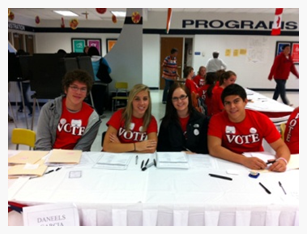Classroom Resources for Local Elections
by Mary Ellen Daneels, Lead Teacher Mentor
Former U.S. Speaker of the House Tip O’Neill famously said, “All politics is local.” Yet, while resources for presidential elections are plentiful, teachers are often left scrambling for local election materials to engage their students. While the news outlets quickly cover the latest candidate to announce for the 2020 presidential campaign, news about local candidates seems sparse in comparison.
The Illinois Social Science standards and high school civics requirement both provide a vision of civic learning that takes inquiry to informed action. In this, students can use the knowledge, skills, and dispositions they are building in the classroom to address real-world problems in their communities.
While access to national and state lawmakers can be limited due to location, proximity to legislative offices, and demanding campaign schedules, local lawmakers often live right next door to our students. They are the parents of peers and the owners of businesses students patronize. In short, they are much more accessible. These community members are the decision makers for policies that MOST affect young people’s everyday life.
A robust civic learning experience for students MUST focus on local elections and how public policy is impacted by the ballot box.
There are several tools from civic organizations and educational partners that provide a foundation for involving students in the 2019 election season. Here is a list to begin with:
- The Center for Information and Research for Civic Learning and Engagement (CIRCLE) has data and analysis related to youth voting trends, suffrage laws, and what works in getting out the youth vote.
- The Illinois State Board of Elections has a page where classrooms can follow who has filed petitions to run for office.
- The Reform for Illinois is a non-partisan organization that provides timely information about how the public can participate in government. In addition, the organization sponsors the Illinois Voter Project to profile how Illinois votes demographically and geographically.
- Vote411 is a site created by the League of Women Voters to help understand local voting regulations. The League of Women Voters-Illinois has resources related to election education. Consider subscribing to your local chapter’s newsletter for information about local candidate forums.
- Track local and national elections or host an election in your classroom with students, historical figures, or book characters as candidates: https://www.scholastic.com/teachers/collections/teaching-content/elections/
- The Constitutional Rights Foundation- Chicago has lesson plans about current and controversial issues related to voting and elections such as lowering the voting age to 16, as well as materials to engage in simulations of democratic processes.
- Facing History and Ourselves has a catalog of materials to provide background information about the expansion of suffrage.
- Rock the Vote offers resources for increasing student involvement in voter registration, as does this Teaching Tolerance.
- BallotReady.org is busy researching candidates and local ballot initiatives so that your students can see a sample ballot and examine their options at the polls.
- Do you want your students to create a voter guide? Here is guidance from the Center for Civic Design to help!
- The Mikva Challenge proves that, “democracy is a verb” with their Elections in Action program that connects students with timely resources and opportunities for service learning.
- Our friends at KQED have a lesson plan to help students make sense of political polling data.
- The 22X20 campaign has resources to educate, activate and facilitate youth voice in elections.
- There is curriculum related to Voting Rights provided by iCivics.org. iCivics also created a webquest to help students learn, “Who Represents Me?”
- Growing Voters has free simulations and lesson plans to engage students in the voting process.
- Love the Vote provides guidance on how to engage students who cannot vote for a variety of reasons (too young, undocumented, legal residents) during election season.
- Dr. Diana Hess, the Dean of the School of Education at the University of Wisconsin-Madison, penned an article in Social Education titled, “Should Schools Teach Students to Vote? YES!” to help teachers make the case for voter education in the classroom.






Comments
Post a Comment